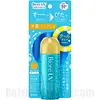What's inside
What's inside
 Key Ingredients
Key Ingredients

 Benefits
Benefits

 Concerns
Concerns

 Ingredients Side-by-side
Ingredients Side-by-side

Water
Skin ConditioningCaprylic/Capric Triglyceride
MaskingTitanium Dioxide
Cosmetic ColorantButylene Glycol
HumectantIsohexadecane
EmollientIsononyl Isononanoate
EmollientIsotridecyl Isononanoate
EmollientNeopentyl Glycol Dicaprate
EmollientPropanediol
SolventTriethylhexanoin
MaskingNeopentyl Glycol Diethylhexanoate
EmollientAluminum Hydroxide
EmollientStearic Acid
CleansingPolysorbate 60
EmulsifyingCetearyl Alcohol
EmollientGlyceryl Behenate
EmollientSorbitan Distearate
EmollientHydrogenated Polyisobutene
EmollientSodium Methyl Stearoyl Taurate
Cleansing2-Hydroxyethyl Acrylate
Acrylamide/Sodium Acryloyldimethyltaurate Copolymer
Emulsion StabilisingDipentaerythrityl Tri-Polyhydroxystearate
EmollientPolyglyceryl-2 Diisostearate
EmulsifyingStearoyl Glutamic Acid
CleansingSodium Acrylate/Sodium Acryloyldimethyl Taurate Copolymer
Emulsion StabilisingArginine
MaskingStearyl Alcohol
EmollientPolyhydroxystearic Acid
EmulsifyingDisodium EDTA
Tromethamine
BufferingDextrin Palmitate
EmulsifyingPolysorbate 80
EmulsifyingPotassium Hydroxide
BufferingButyrospermum Parkii Butter
Skin ConditioningPhenoxyethanol
PreservativeSodium Dehydroacetate
PreservativeXanthan Gum
EmulsifyingParfum
MaskingWater, Caprylic/Capric Triglyceride, Titanium Dioxide, Butylene Glycol, Isohexadecane, Isononyl Isononanoate, Isotridecyl Isononanoate, Neopentyl Glycol Dicaprate, Propanediol, Triethylhexanoin, Neopentyl Glycol Diethylhexanoate, Aluminum Hydroxide, Stearic Acid, Polysorbate 60, Cetearyl Alcohol, Glyceryl Behenate, Sorbitan Distearate, Hydrogenated Polyisobutene, Sodium Methyl Stearoyl Taurate, 2-Hydroxyethyl Acrylate, Acrylamide/Sodium Acryloyldimethyltaurate Copolymer, Dipentaerythrityl Tri-Polyhydroxystearate, Polyglyceryl-2 Diisostearate, Stearoyl Glutamic Acid, Sodium Acrylate/Sodium Acryloyldimethyl Taurate Copolymer, Arginine, Stearyl Alcohol, Polyhydroxystearic Acid, Disodium EDTA, Tromethamine, Dextrin Palmitate, Polysorbate 80, Potassium Hydroxide, Butyrospermum Parkii Butter, Phenoxyethanol, Sodium Dehydroacetate, Xanthan Gum, Parfum
Water
Skin ConditioningAlcohol
AntimicrobialEthylhexyl Methoxycinnamate
UV AbsorberGlycerin
HumectantEthylhexyl Triazone
UV AbsorberSilica
AbrasiveDiethylamino Hydroxybenzoyl Hexyl Benzoate
UV FilterGlyceryl Stearate
EmollientBis-Ethylhexyloxyphenol Methoxyphenyl Triazine
Skin ConditioningDextrin Palmitate
EmulsifyingPolyvinyl Alcohol
Agar
MaskingCellulose
AbsorbentMenthyl Lactate
MaskingDisodium EDTA
Menthol
MaskingAcrylates/C10-30 Alkyl Acrylate Crosspolymer
Emulsion StabilisingSodium Hydroxide
BufferingParfum
MaskingBHT
AntioxidantPolysilicone-9
Royal Jelly Extract
Skin ConditioningSodium Hyaluronate
HumectantPhenoxyethanol
PreservativeMethylparaben
PreservativeWater, Alcohol, Ethylhexyl Methoxycinnamate, Glycerin, Ethylhexyl Triazone, Silica, Diethylamino Hydroxybenzoyl Hexyl Benzoate, Glyceryl Stearate, Bis-Ethylhexyloxyphenol Methoxyphenyl Triazine, Dextrin Palmitate, Polyvinyl Alcohol, Agar, Cellulose, Menthyl Lactate, Disodium EDTA, Menthol, Acrylates/C10-30 Alkyl Acrylate Crosspolymer, Sodium Hydroxide, Parfum, BHT, Polysilicone-9, Royal Jelly Extract, Sodium Hyaluronate, Phenoxyethanol, Methylparaben
Ingredients Explained
These ingredients are found in both products.
Ingredients higher up in an ingredient list are typically present in a larger amount.
Dextrin Palmitate comes from the palmitic acid ester of Dextrin. It is used as an emulsifier and texture enhancer.
Emulsifiers help keep ingredients together. According to a manufacturer, dextrin palmitate helps create a low-viscosity gel texture.
Due to its fatty acid base, this ingredient is not fungal-acne safe.
Learn more about Dextrin PalmitateDisodium EDTA plays a role in making products more stable by aiding other preservatives.
It is a chelating agent, meaning it neutralizes metal ions that may be found in a product.
Disodium EDTA is a salt of edetic acid and is found to be safe in cosmetic ingredients.
Learn more about Disodium EDTAParfum is a catch-all term for an ingredient or more that is used to give a scent to products.
Also called "fragrance", this ingredient can be a blend of hundreds of chemicals or plant oils. This means every product with "fragrance" or "parfum" in the ingredients list is a different mixture.
For instance, Habanolide is a proprietary trade name for a specific aroma chemical. When used as a fragrance ingredient in cosmetics, most aroma chemicals fall under the broad labeling category of “FRAGRANCE” or “PARFUM” according to EU and US regulations.
The term 'parfum' or 'fragrance' is not regulated in many countries. In many cases, it is up to the brand to define this term.
For instance, many brands choose to label themselves as "fragrance-free" because they are not using synthetic fragrances. However, their products may still contain ingredients such as essential oils that are considered a fragrance by INCI standards.
One example is Calendula flower extract. Calendula is an essential oil that still imparts a scent or 'fragrance'.
Depending on the blend, the ingredients in the mixture can cause allergies and sensitivities on the skin. Some ingredients that are known EU allergens include linalool and citronellol.
Parfum can also be used to mask or cover an unpleasant scent.
The bottom line is: not all fragrances/parfum/ingredients are created equally. If you are worried about fragrances, we recommend taking a closer look at an ingredient. And of course, we always recommend speaking with a professional.
Learn more about ParfumPhenoxyethanol is a preservative that has germicide, antimicrobial, and aromatic properties. Studies show that phenoxyethanol can prevent microbial growth. By itself, it has a scent that is similar to that of a rose.
It's often used in formulations along with Caprylyl Glycol to preserve the shelf life of products.
Water. It's the most common cosmetic ingredient of all. You'll usually see it at the top of ingredient lists, meaning that it makes up the largest part of the product.
So why is it so popular? Water most often acts as a solvent - this means that it helps dissolve other ingredients into the formulation.
You'll also recognize water as that liquid we all need to stay alive. If you see this, drink a glass of water. Stay hydrated!
Learn more about Water